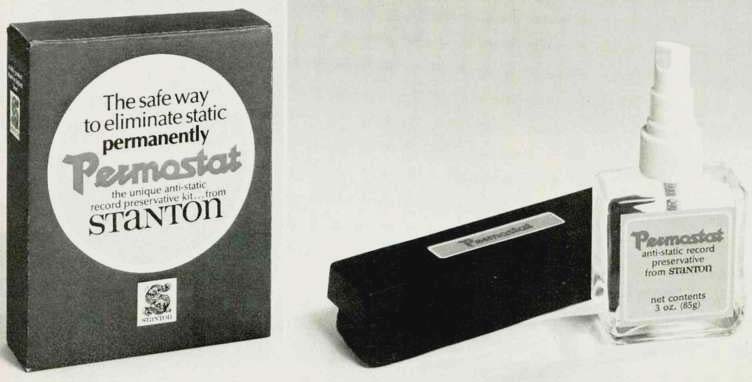
Price: $19.95.
In the past year or so, we have literally been deluged with record-care products. It would seem that almost all at once the record-playing public has become aware of the importance of keeping records clean, dust free, properly stored and, if possible, free of static charges. Nor have record-care products been confined to items intended for application to the record itself. Now there are cleaning kits for styli, timers which are designed to tell you when your diamond stylus may be ready for replacement, and many more.
There was a time when audio enthusiasts weren't even aware of the problems connected with static charges on a record. That was in the days of shellac records, which have long been superseded by polyvinyl chloride pressings. PVC records are a highly insulating material and are therefore very susceptible to static charges, particularly through frictional contact. Charges of as high as 20,000 volts and more have been measured on the surfaces of highly polished records.
Such static charges tend to draw free-floating dust particles onto the record where they can be pushed around or even "welded" into the record grooves by the heat and pressure generated by the stylus, causing increased record wear, noise, and distortion. A highly charged record surface can also cause uneven attraction of the cartridge itself, altering vertical-tracking angle and stylus-tracking force which, in extreme cases can even increase wow and flutter. Discharges of static via the stylus to ground can also result in audible pops and clicks during record playing.
Over the past few years there have been several products made available which have as their sole purpose the elimination of static charges on a record surface. We have seen ion guns that resemble futuristic space weapons, conductive turntable mats, liquids which in addition to cleaning and reducing friction in record grooves also have anti-static additives; you name it.
Now, Stanton Magnetics has begun to market a product called Permostat. Originally developed by Milty Products Co. in Great Britain, claims for the product are that it "totally and permanently eliminates static for the normal considered record life expectancy without any detectable change in sound quality, surface noise, frequency response, or fidelity." That's quite a statement, and if it were not for the fact that the product is being sold in this country by as reputable and well known a manufacturer as Stanton, we might well have dismissed the claim (and the product) out of hand.
The product, Permostat, consists of a 3-ounce bottle of clear fluid and a felt-like buffing pad. The bottle containing the fluid is capped with a finger pump arrangement which, when depressed, forces a fine spray of liquid from its nozzle.
Instructions indicate that approximately 8 to 10 sprays will cover one side of an LP record. Of course, both sides of a disc must be fully treated in order for Permostat to be effective. Based upon these requirements, the fluid supplied should be enough to treat between 25 and 30 12-in. LPs. The velvet pad is used to buff the surface of the record until it is shiny. Once the record is treated and buffed on both sides, the makers say that it can be played immediately. Identifying self-adhesive tabs are supplied with the kit so that treated records can be identified.
Testing The Product
There were three areas of testing which we decided to pursue. First and foremost, we wanted to determine whether the claims for "permanent" destaticizing of a record through the application of Permostat were true. Next, we wanted to determine whether the application of this fluid would in any measurable way degrade audible performance of records.
Finally, we wanted to do some careful listening to records before treatment, after treatment, and after repeated playings for a subjective comparison.
Measuring Static Charge
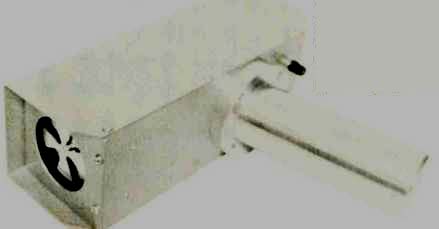
Fig. 1 --Overall view of field mill used to measure the static charge levels
on phonograph records.
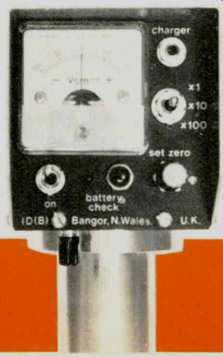
Fig. 2 --Meter on rear of field mill test instrument reads directly in volts/cm
and also indicates polarity of the static charge.
Measurement of static charges were made using a precision-built, hand-held integrated field mill specially designed and developed for measuring static charges on insulating surfaces. The battery-powered instrument, made by Industrial Development, Bangor, North Wales, U.K., is pictured in Fig. 1. This field mill, in addition to quantifying static charge in volts/centimeter also indicates whether a charge is negative or positive. A close up of the control and meter portion of the instrument (at the rear of the device) is shown in Fig. 2.
Three ranges of meter sensitivity are provided, making it possible to read all the way to "zero volts" and up to 10,000 volts. Readings on the meter are then multiplied by the distance between the sensing end of the instrument and the surface whose charge is being measured. For example, if the meter reads 3,000 volts and the sensing rotors are 4 centimeters from the surface being measured, the static charge on the surface has an amplitude of 12,000 volts.
Test Records
We used two identical copies of CBS Test Record STR-130 for measuring the effective charge on a PVC disc with and without Permostat treatment and for determining the effect, if any, on frequency response, noise, and distortion when Permostat is applied.
The test record chosen contains spot frequencies from 20 kHz down to 20 Hz with identifying voice announcements. A reference 1-kHz tone is also included, followed by a long leadout groove (silent) which was used to determine initial distortion and surface-noise levels and those same parameters after 100 playings. The 29 spot frequencies were used to plot frequency response for an untreated and a treated disc during mint-condition playing and after 100 plays.
Figure 3 is a plot of frequency response for the untreated record during its first playing (solid curve) and after 100 playings using an elliptical stylus with a downward tracking force of 1.5 grams. The amplitude scale of the graph has been deliberately expanded to show minute changes in response.
Clearly, for the untreated record, some deterioration in high-frequency response has occurred. A second record, treated with Permostat, was also measured and plotted during its first playing and after 100 plays. As shown in Fig. 4, consider ably less loss of high frequencies has occurred in the case of this treated record.
During the 100 plays of both the untreated and treated discs, measurements were made periodically to determine static charge level on each disc. At the conclusion of the tests, each disc was rather violently rubbed with a silk hand kerchief to induce static charge. Results, measured with the field mill, are summarized in Table I. They dramatically con firm the claims made for Stanton Permostat, at least on a short-term basis (the 100 playings were done consecutively, over a period of no more than two or three days).
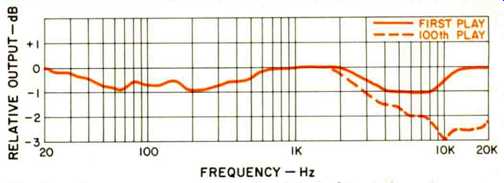
Fig. 3 --Frequency response of untreated test record during first play and
after 100 playings.
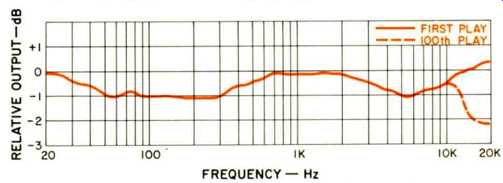
Fig. 4 --Frequency response of test record treated with Permostat during
first play and after 100 playings.
Harmonic Distortion Measurements
Next, using the 1000-Hz reference tone on Test Record STR-130, we applied the output of a connected equalizer/ preamplifier to our spectrum analyzer. Figure 5 displays results obtained with the first playing of the untreated disc.
The tall spike in this and all subsequent scope photos represents the desired 1-kHz fundamental. The next spike to the right represents second-order distortion and is largely a function of tonearm/cartridge geometry. Of interest in our tests were the higher order distortion products; 3rd-, 4th-, and 5th-order components are visible in Fig. 5. Analysis of distortion was repeated after 100 playings of the untreated disc, and results are shown in Fig. 6. Note that 3rd-order distortion has risen noticeably after 100 plays (scale is 10 dB per vertical division).
Similar tests were analyzed with the treated disc. Figure 7 shows harmonic distortion content during first playing of the treated disc, while Fig. 8 displays the results obtained for the treated disc after 100 playings. If anything, the 3rd-order distortion has actually gotten somewhat lower after repeated playing. Certainly, overall THD has not increased after 100 playings of the treated disc.
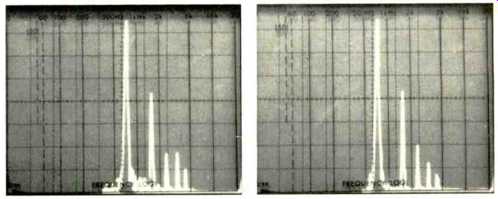
Fig. 5--Spectrum analysis of 1-kHz signal from untreated record after first
playing. Fig. 6--Spectrum analysis of 1-kHz signal from untreated test
record after 100 playings.
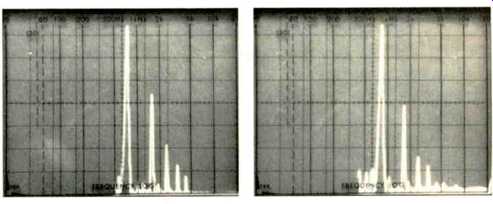
Fig. 7 --Spectrum analysis of 1-kHz signal from Permostat-treated test record
after first playing. Fig. 8--Spectrum analysis of 1-kHz signal from Permostat-treated
test record after 100 playings.
Surface Noise Tests
Employing much the same technique, we analyzed surface noise content for the untreated and treated records, both during initial playing and after 100 plays, by employing the silent-groove portion of the test record. Figure 9 shows the noise distribution vs. frequency observed during the first playing of the untreated disc. Figure 10 shows noise distribution in the same disc after 100 plays. Note that at the right hand portion of the sweep (higher frequencies), noise con tent has increased significantly.
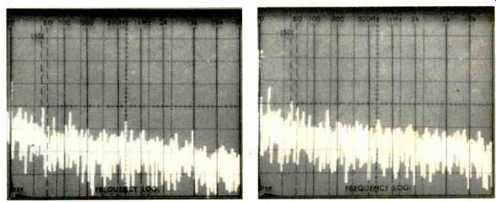
Fig. 9--Spectrum analysis of surface noise content in "silent groove" portion
of untreated test record during first play. Fig. 10--Spectrum analysis of surface
noise content of "silent groove" portion of untreated test record after
100 playings.
Figure 11 shows noise distribution in the audio range for the treated disc, during its first playing, while Fig. 12 shows noise distribution in that same disc after it was played 100 times. Clearly, there has been no increase in average noise content in any portion of the audio spectrum.
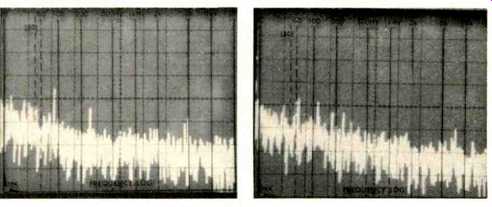
Fig. 11--Spectrum analysis of surface noise content in "silent groove" portion
of Permostat-treated record during first play. Fig. 12 --Spectrum analysis
of surface noise content in "silent groove" portion of Permostat-treated
test record after 100 playings.
----
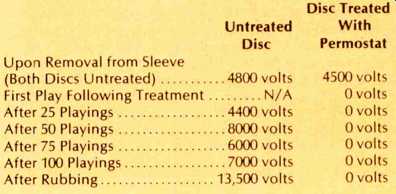
Table I: Average Static Charge Measured on Disc Surfaces.
----
Subjective Listening Tests
In addition to treating the test records, we also experimented with a few commercially available direct-to-disc records, among them Big Band Jazz and Efrem Zimbalist, Father & Son, both distributed under the Umbrella Label (UMB-DD4 and UMB-DD3), Tri-centennial of Vivaldi (Sonic Arts Lab Series), and David Montgomery: The Piano (Sonic Arts). These were first played in mint, untreated condition and were then treated with Stanton's Permostat. Again, treated records exhibited no measurable charge when measured with the field mill, even after several playings, insertions into and withdrawal from record sleeves, and repeated attempts to induce a charge artificially. More importantly we could detect no difference when comparing playback of these discs with playback of an additional copy of each disc that had not been treated with Permostat.
It has now been several weeks since we measured the static charge on the treated and untreated test records and on the musical records we auditioned for the tests. To date, the treated records still exhibit no measurable static charge nor can a voltage charge be induced upon their surfaces deliberately. While I have no knowledge whatever of what "magic" substance is contained in the clear liquid we applied, I can say without reservation that the stuff works, as claimed, and that based upon our tests, it does not degrade sound quality of records that have been treated with it.
In discussing my results with the folks at Stanton, I asked them whether they had been able to verify Permostat's effect on record grooves in a more direct manner than I had been able to do by my indirect measurements. I was aware that Stanton Magnetics owned an electronic microscope by means of which they could examine and photograph record grooves at tremendous magnification levels. While I was perfectly content with my own test results and was ready to accept the fact that Permostat actually prevented record wear in addition to providing permanent anti-static qualities, it is one thing to ascertain these qualities by indirect analysis and quite another to be able to examine "before and after" photos of the record grooves themselves. Accepting the challenge, George Alexandrovich, an engineer with Stanton, sup plied me with two photos, reproduced here in Figs. 13 and 14. Figure 13 is a photo of one record groove (magnified 5000 times) taken of an untreated record that had been played 100 times with an elliptical stylus at 3 grams vertical tracking force, using a Stanton 680 SE stylus. No anti-skating force was applied, and you can clearly see greater groove wear on the left wall than on the right.
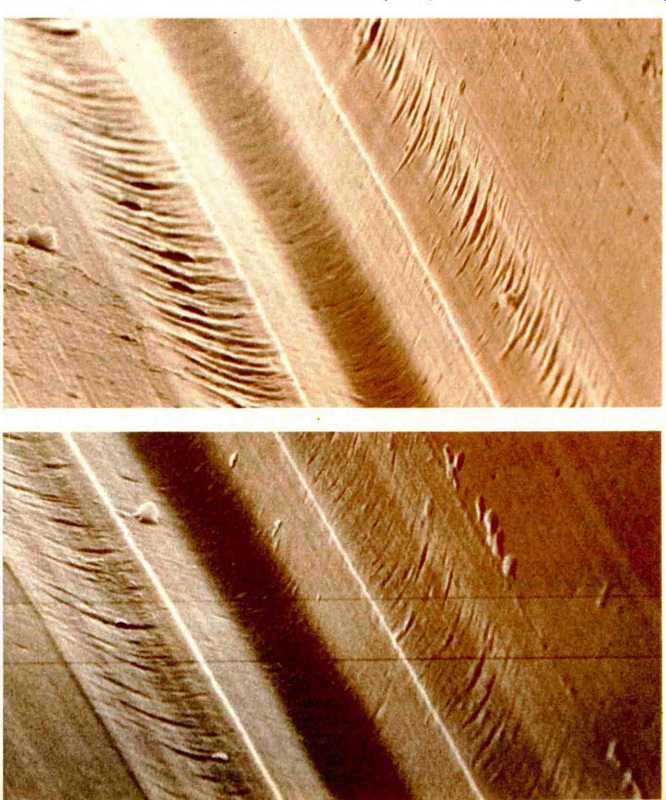
(top) Fig. 13--Magnified view of single groove of untreated record after 100
playings. (above) Fig. 14--Magnified view of single groove of Permostat-treated
record after 100 playings.
Contrast this with Fig. 14, a photo of one groove of a Permostat treated record that had been played the same 100 times with the same vertical tracking force, and you have ample proof of the wear-retarding qualities of Permostat.
Needless to say, I am most envious of Stanton Magnetics. If I had access to that electron microscope I could have saved myself weeks of tedious work and drawn the same conclusions simply by examining this pair of photos. I was, however, gratified to find that my results, however crude by comparison, were confirmed by these pictures.
To conclude this report, I decided to pull out that treated test record once again (it is now four months since the disc was treated) and measure static charge for the last time. It still measures "zero volts"!
-Leonard Feldman
(Source: Audio magazine, May 1979)
Also see:
Stanton Magnetics (ad, Nov. 1978)
= = = =